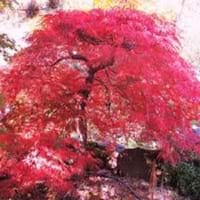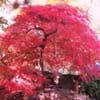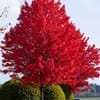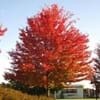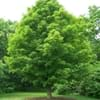Life Span
Perennial
Perennial
Origin
Eastern Asia
Africa, India, Southeast Asia
Types
Ever red , Crimson queen
Sweet Tamarind, Australian tamarind, Manila tamarind, Velvet tamarind, Spanish Tamarind
Number of Varieties
Not Available
Habitat
Shady Edge
Subtropical climates, Tropical regions
USDA Hardiness Zone
5-8
9-11
AHS Heat Zone
8-2
Not Available
Sunset Zone
A3, 2a, 2b, 3a, 3b, 4, 5, 6, 7, 8, 9, 10, 12, 14, 15, 16, 17, 18, 19, 20, 21, 22, 23, 24
Not Available
Habit
Arching/Fountain-shaped
Spreading
Flower Color
Red
Red, Yellow
Flower Color Modifier
Bicolor
Bicolor
Fruit Color
Red, Green
Brown
Leaf Color in Spring
Light Green, Lime Green
Green
Leaf Color in Summer
Green, Lime Green
Dark Green, Green
Leaf Color in Fall
Orange, Gold, Orange Red
Dark Green, Yellow green
Leaf Color in Winter
Not Available
Dark Brown, Green
Leaf Shape
Maple shaped
Pinnate
Plant Season
Spring, Summer, Fall, Winter
Spring, Summer, Fall, Winter
Sunlight
Full Sun, Partial Sun, Partial shade
Full Sun, Partial Sun
Type of Soil
Clay, Loam, Sand
Clay, Loam, Sand
The pH of Soil
Acidic, Neutral
Acidic
Soil Drainage
Average
Average
Bloom Time
Early Spring, Spring, Late Spring, Early Summer
Late Spring
Tolerances
Drought
Drought, Salt
Where to Plant?
Ground
Ground
How to Plant?
Transplanting
Layering, Seedlings, Transplanting
Plant Maintenance
Medium
Low
Watering Requirements
Requires regular watering
Do Not over Water, Keep the ground moist but not water-logged
In Summer
Lots of watering
Lots of watering
In Spring
Moderate
Moderate
In Winter
Average Water
Average Water
Soil pH
Acidic, Neutral
Acidic
Soil Type
Clay, Loam, Sand
Clay, Loam, Sand
Soil Drainage Capacity
Average
Average
Sun Exposure
Full Sun, Partial Sun, Partial shade
Full Sun, Partial Sun
Pruning
Remove damaged leaves, Remove dead branches, Remove dead leaves
Remove damaged leaves, Remove dead branches, Remove dead leaves
Fertilizers
All-Purpose Liquid Fertilizer
6-6-6 or 8-8-8
Pests and Diseases
Red blotch
Aphids, Borers, Mealybugs, Onion thrips, Root weevil, Soft scales, Whiteflies
Plant Tolerance
Drought
Drought
Flowers
Insignificant
Showy
Flower Petal Number
Single
Single
Foliage Texture
Fine
Bold
Foliage Sheen
Matte
Matte
Attracts
Beetles
Beetles, Birds, Scale Insects
Allergy
Unknown
Diarrhea, Hives, Nausea, Vomiting
Aesthetic Uses
Beautification, Bonsai, Landscape Designing, Showy Purposes
Beautification
Beauty Benefits
Not Available
Glowing Skin, Good for skin, Improve skin tone, Reduces ageing, Skin cleanser
Edible Uses
Not Available
Yes
Environmental Uses
Air purification
Food for animals, Food for birds, Food for insects, Nesting sites for birds
Medicinal Uses
Unknown
Antioxidants, Inflammation, Rheumatism, Skin Disorders, Sore throat
Part of Plant Used
Not Available
Flowers, Fruits, Leaves
Other Uses
Not Available
Culinary use, Used as a nutritious food item, Used as Ornamental plant, Used for its medicinal properties
Used As Indoor Plant
No
No
Used As Outdoor Plant
Yes
Yes
Garden Design
Container, Feature Plant, Hedges, Mixed Border, Topiary / Bonsai / Espalier
Edible, Fruit / Fruit Tree, Shade Trees
Botanical Name
ACER palmatum 'Omurayama'
Tamarindus indica
Common Name
Japanese Maple, Weeping Japanese Maple
Tamarind tree, Tamarind
In Hindi
Weeping Maple
इमली का पेड़
In German
Weeping Maple
Tamarinde
In French
Maple pleureur
tamarinier
In Spanish
weeping maple
tamarindo
In Greek
weeping maple
δέντρο Tamarind
In Portuguese
chorando de bordo
tamarindo
In Polish
płacz klonu
drzewo tamaryndowca
In Latin
weeping maple
tamarind ligno
Phylum
Angiosperms
Magnoliophyta
Class
Eudicotyledones
Magnoliopsida
Family
Aceraceae
Fabaceae
Clade
Not Available
Angiosperms, Eudicots, Rosids
Tribe
Not Available
Detarieae
Subfamily
Not Available
Caesalpinioideae
Number of Species
Not Available
Not Available
Importance of Weeping Maple and Tamarind tree
Want to have the most appropriate plant for your garden? You might want to know the importance of Weeping Maple and Tamarind tree. Basically, these two plants vary in many aspects. Compare Weeping Maple and Tamarind tree as they differ in many characteristics such as their life, care, benefits, facts, etc. Every gardener must at least have the slightest clue about the plants he wants to plant in his garden. Compare their benefits, which differ in many ways like facts and uses. The medicinal use of Weeping Maple is Unknown whereas of Tamarind tree is Antioxidants, Inflammation, Rheumatism, Skin Disorders and Sore throat. Weeping Maple has beauty benefits as follows: Not Available while Tamarind tree has beauty benefits as follows: Not Available.
Compare Facts of Weeping Maple vs Tamarind tree
How to choose the best garden plant for your garden depending upon its facts? Here garden plant comparison will help you to solve this query. Compare the facts of Weeping Maple vs Tamarind tree and know which one to choose. As garden plants have benefits and other uses, allergy is also a major drawback of plants for some people. Allergic reactions of Weeping Maple are Unknown whereas of Tamarind tree have Diarrhea, Hives, Nausea and Vomiting respectively. Having a fruit bearing plant in your garden can be a plus point of your garden. Weeping Maple has no showy fruits and Tamarind tree has no showy fruits. Also Weeping Maple is not flowering and Tamarind tree is not flowering . You can compare Weeping Maple and Tamarind tree facts and facts of other plants too.
